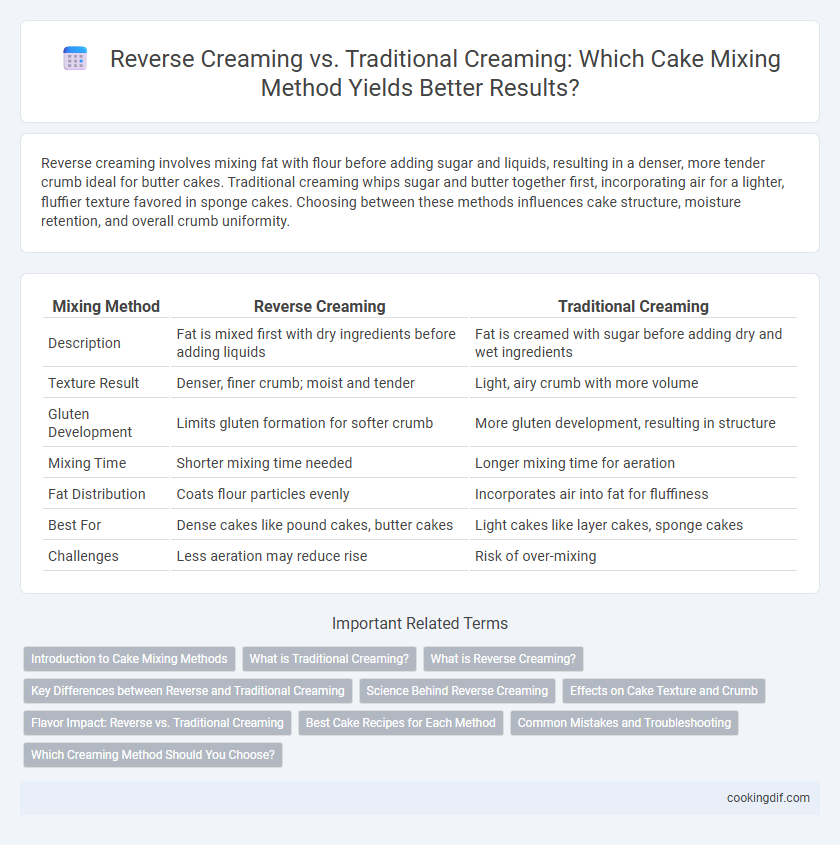Reverse creaming involves mixing fat with flour before adding sugar and liquids, resulting in a denser, more tender crumb ideal for butter cakes. Traditional creaming whips sugar and butter together first, incorporating air for a lighter, fluffier texture favored in sponge cakes. Choosing between these methods influences cake structure, moisture retention, and overall crumb uniformity.
Table of Comparison
| Mixing Method | Reverse Creaming | Traditional Creaming |
|---|---|---|
| Description | Fat is mixed first with dry ingredients before adding liquids | Fat is creamed with sugar before adding dry and wet ingredients |
| Texture Result | Denser, finer crumb; moist and tender | Light, airy crumb with more volume |
| Gluten Development | Limits gluten formation for softer crumb | More gluten development, resulting in structure |
| Mixing Time | Shorter mixing time needed | Longer mixing time for aeration |
| Fat Distribution | Coats flour particles evenly | Incorporates air into fat for fluffiness |
| Best For | Dense cakes like pound cakes, butter cakes | Light cakes like layer cakes, sponge cakes |
| Challenges | Less aeration may reduce rise | Risk of over-mixing |
Introduction to Cake Mixing Methods
Reverse creaming involves mixing fat with flour before adding liquids, producing a finer crumb and tender texture in cakes. Traditional creaming combines butter and sugar first, incorporating air for a lighter, fluffier cake structure. Choosing between these methods affects the cake's density, moisture, and overall crumb quality.
What is Traditional Creaming?
Traditional creaming is a cake mixing method where butter and sugar are beaten together until light and fluffy, incorporating air that helps leaven the cake. This technique creates a tender crumb by evenly distributing fat and trapping air bubbles, essential for cake rise and texture. It contrasts with reverse creaming by starting with fat and sugar before adding eggs and flour, ensuring a light and moist cake structure.
What is Reverse Creaming?
Reverse creaming is a cake mixing method where fat, usually butter, is mixed with dry ingredients like flour before adding liquids. This technique coats flour proteins with fat, reducing gluten formation and producing a finer, tender crumb. Unlike traditional creaming, which starts by beating butter and sugar, reverse creaming ensures a denser, smoother cake texture ideal for delicate recipes.
Key Differences between Reverse and Traditional Creaming
The reverse creaming method combines flour with fat before adding sugar and liquids, creating a finer crumb and denser texture by coating flour proteins to limit gluten formation. Traditional creaming whips sugar into butter first, incorporating air to produce a lighter, fluffier cake with more volume. Key differences include gluten development control in reverse creaming for tender cakes versus aeration focus in traditional creaming for a more open crumb.
Science Behind Reverse Creaming
Reverse creaming, also known as the paste method, involves mixing fat with flour before adding liquids, which coats the flour proteins and limits gluten development, leading to a tender, fine crumb in cakes. This technique promotes a more uniform fat distribution, resulting in a moist and dense texture by reducing the cake's rise and crumb coarseness compared to traditional creaming. Scientific studies on batter rheology confirm that reverse creaming creates a more stable emulsion, enhancing cake structure and shelf-life.
Effects on Cake Texture and Crumb
Reverse creaming creates a finer, more tender crumb by coating flour proteins with fat before adding liquids, reducing gluten development and resulting in a denser, velvety texture. Traditional creaming incorporates air by beating butter and sugar first, producing a lighter, fluffier crumb with increased volume and a more open structure. Choosing reverse creaming yields a moist, tight crumb ideal for pound cakes, while traditional creaming suits airy, tender cakes like sponge or butter cakes.
Flavor Impact: Reverse vs. Traditional Creaming
Reverse creaming enhances cake flavor by minimizing gluten development, resulting in a tender crumb that allows butter and sugar to deliver a rich, buttery taste more effectively. Traditional creaming aerates the batter, promoting a lighter texture but can lead to more gluten formation, which may slightly mask the pure flavor of the butter. The reverse creaming method intensifies flavor clarity, making it ideal for butter-centric cake recipes seeking a moist, flavorful outcome.
Best Cake Recipes for Each Method
Reverse creaming, which involves mixing fat with dry ingredients before adding liquids, is ideal for denser, tender cakes like pound cakes and butter cakes, ensuring a fine, even crumb. Traditional creaming, where butter and sugar are beaten together first, is best suited for airy, light cakes such as classic chocolate or vanilla sponge cakes, promoting volume and a fluffy texture. Selecting the appropriate creaming method directly influences the final cake's texture and structure, making it essential to match the technique with the recipe for optimal results.
Common Mistakes and Troubleshooting
Reverse creaming often leads to denser cakes if flour is not properly mixed with fat, causing uneven gluten development and tough texture. In traditional creaming, overbeating butter and sugar traps excess air, resulting in coarse crumb or collapsing cakes. Troubleshooting involves closely monitoring mixing times and ensuring ingredient temperatures are optimal to achieve uniform batter consistency.
Which Creaming Method Should You Choose?
Reverse creaming involves mixing fat and flour before adding sugar and eggs, resulting in a denser, finer crumb perfect for pound cakes and butter cakes. Traditional creaming, where butter and sugar are beaten first until fluffy, incorporates more air, making it ideal for lighter, spongier cakes like layer and birthday cakes. Choose reverse creaming for moisture retention and a tender texture, while traditional creaming suits recipes needing volume and lightness.
Reverse creaming vs Traditional creaming for cake mixing method Infographic

 cookingdif.com
cookingdif.com